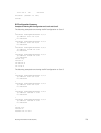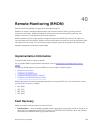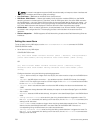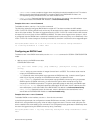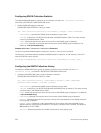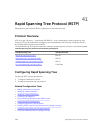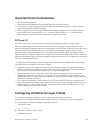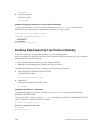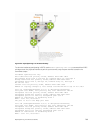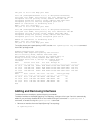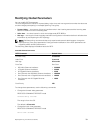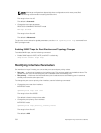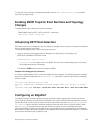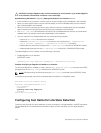Important Points to Remember
• RSTP is disabled by default.
• Dell Networking OS supports only one Rapid Spanning Tree (RST) instance.
• All interfaces in virtual local area networks (VLANs) and all enabled interfaces in Layer 2 mode are
automatically added to the RST topology.
• Adding a group of ports to a range of VLANs sends multiple messages to the rapid spanning tree
protocol (RSTP) task, avoid using the range command. When using the range command, Dell
Networking recommends limiting the range to five ports and 40 VLANs.
RSTP and VLT
Virtual link trunking (VLT) provides loop-free redundant topologies and does not require RSTP.
RSTP can cause temporary port state blocking and may cause topology changes after link or node
failures. Spanning tree topology changes are distributed to the entire Layer 2 network, which can cause a
network-wide flush of learned media access control (MAC) and address resolution protocol (ARP)
addresses, requiring these addresses to be re-learned. However, enabling RSTP can detect potential
loops caused by non-system issues such as cabling errors or incorrect configurations. RSTP is useful for
potential loop detection but to minimize possible topology changes after link or node failure, configure it
using the following specifications.
The following recommendations help you avoid these issues and the associated traffic loss caused by
using RSTP when you enable VLT on both VLT peers:
• Configure any ports at the edge of the spanning tree’s operating domain as edge ports, which are
directly connected to end stations or server racks. Ports connected directly to Layer 3-only routers
not running STP should have RSTP disabled or be configured as edge ports.
• Ensure that the primary VLT node is the root bridge and the secondary VLT peer node has the
second-best bridge ID in the network. If the primary VLT peer node fails, the secondary VLT peer
node becomes the root bridge, avoiding problems with spanning tree port state changes that occur
when a VLT node fails or recovers.
• Even with this configuration, if the node has non-VLT ports using RSTP that are not configured as
edge ports and are connected to other layer 2 switches, spanning tree topology changes can still be
detected after VLT node recovery. To avoid this scenario, ensure that you configure any non-VLT
ports as edge ports or have RSTP disabled.
Configuring Interfaces for Layer 2 Mode
To configure and enable interfaces in Layer 2 mode, use the following commands.
All interfaces on all bridges that participate in Rapid Spanning Tree must be in Layer 2 and enabled.
1. If the interface has been assigned an IP address, remove it.
INTERFACE mode
no ip address
2. Place the interface in Layer 2 mode.
INTERFACE mode
Rapid Spanning Tree Protocol (RSTP)
787



